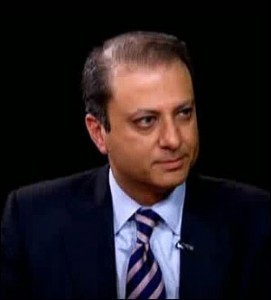Courtesy of Pam Martens
The narrative of Preet Bharara as a crusading crime fighter has gotten a big boost from the Editorial Board of the New York Times in a glowing editorial in today’s print edition. Bharara was, until this past weekend, the U.S. Attorney for the Southern District of New York, Wall Street’s stomping ground. Bharara Tweeted on Saturday that he had been “fired” by the Trump administration.
The Times’ editorial headline in its digital edition has to be bringing howls this morning from Wall Street veterans and corporate crime watchers. The Times is asking its readers to believe that Bharara was a “Prosecutor Who Knew How to Drain a Swamp.” That’s fake news at its finest. Despite Jamie Dimon, CEO of JPMorgan Chase, Lloyd Blankfein, CEO of Goldman Sachs, and Michael Corbat, CEO of Citigroup, presiding over an unprecedented series of frauds upon the investing public at their banks, these men remain firmly entrenched as overpaid titans in the impenetrable toxic muck of the Wall Street Swamp.
We’ll get back shortly to Bharara’s tenure in the financial crime capitol of the world, but first some necessary background on the New York Times itself.
The Times has a new advertising slogan. It goes like this: “Truth. It’s hard to find. But easier with 1000+ journalists looking. Subscribe to The Times.” Unfortunately, when it comes to New York’s biggest and richest hometown industry known as Wall Street, those 1,000 journalists regularly have dull pencils and fogged lenses. (See related articles below.) Even worse, the Editorial Board at the Times has repeatedly served as a propagandist for the serial Wall Street ruses to fleece the public.
It was the Editorial Board of the Times that played the role of Head Majorette when Sandy Weill needed support for his self-serving plan to repeal the Glass-Steagall Act, allowing Wall Street investments banks to merge with commercial banks holding federally-insured deposits in order to make wild gambles for the house while putting taxpayers on the hook for the losses. John Reed, Weill’s partner in the plan, explained to Bill Moyers’in 2012 the real motivation behind the scheme: “Sandy Weill. I mean, his whole life was to accumulate money. And he said, ‘John, we could be so rich.’ Being rich never crossed my mind as an objective value. I almost was embarrassed that somebody would say out loud. It might be happening but you wouldn’t want to say it.”
…




